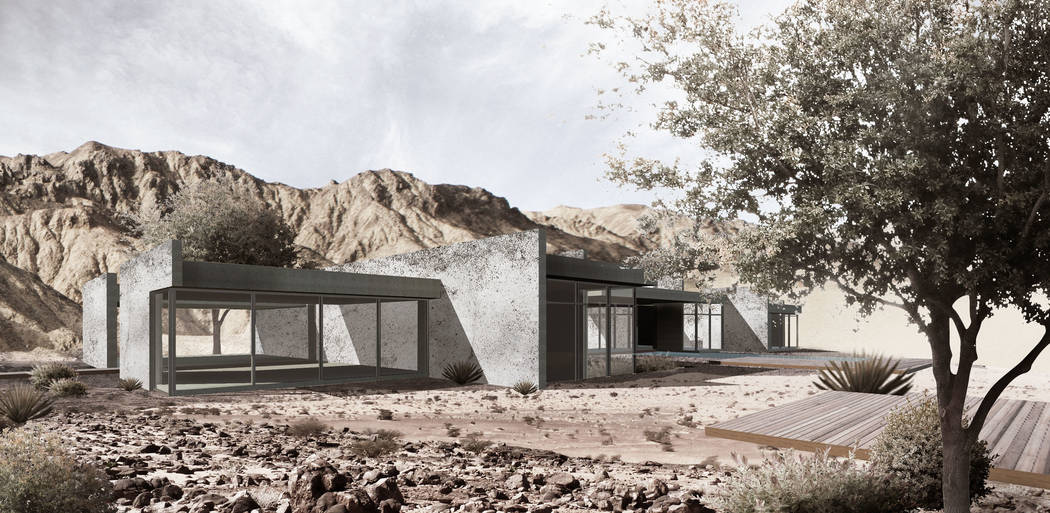UNLV architecture students showcase modern design talents at Ascaya

Five students from the University of Nevada, Las Vegas, School of Architecture, under the direction of professor Eric Strain, recently completed an innovative project that stretched their understanding of modern architecture. Using a designated home site at Ascaya, the students created architectural designs in the desert contemporary theme of the community. The students’ work will be displayed at an event that is open to the public 1-4 p.m. Nov. 4.
Each home showcases the students’ talents in unique ways with new twists on the desert contemporary style. The homes, which are all 5,000 square feet, were required to include a living space, two bedrooms and a pool. Students Bryce Shintaku, Jenn Wong, Eduardo Gonzalez, Jorge Hernandez and Kimberly Galbe created architectural plans for the site.
“The physical characteristics of the site made it ideal for the project, as it is terraced from the street level and allows privacy from vehicular traffic and pedestrians,” Shintaku said. “The most influential characteristic of the site is that it is a peninsula built on the edge of the entire Ascaya property line. This allows the occupant to see 360 degrees with views of the city of Las Vegas, Las Vegas Strip, McCullough mountains and Red Rock Canyon.”
Shintaku’s design included two rammed-earth walls with colors that reflected the earth tones in Ascaya’s surrounding mountain ranges.
“The rammed earth is taller and longer than the house itself, creating a feeling of hierarchy as if it is supporting a substructure,” he said. “The rammed earth is present in every room, making the occupant constantly aware of the environment, site and orientation of the house.”
Eduardo Gonzalez’s design also included a signature wall to honor the mountain range. “I’ve hiked and mountain biked that area and always liked the idea of the black mountains, so I created a black wall that gives an impression of a black canyon,” he said.
The home’s main elements were concrete, stone and glass with two separate structures connected by a bridge. “The area below the bridge is designed like a wash, which gives a natural feeling with trees and vegetation.”
Gonzalez said his inspiration was a home his parents own in Southern Mexico. “In both homes, you enter from the top level with public spaces on that level and living spaces on the lower level,” he said. “I took that concept, then opened it up with different wings.”
“This project was really challenging to think about what kind of spaces I might want in the future since we were the intended users of the designs,” said Gonzalez. “Instead of designing what was comfortable, I designed what was possible. I made my bedroom larger, overlooking the pool and in its own wing.”
“My house was really designed for security and privacy,” said Jenn Wong. “I designed a separate main residence with a detached garage that has a studio space above it. There is a complete separation of the public and private space.”
Wong said one of her inspirations was the Los Angeles County Museum of Art’s “Rain Room” exhibit. “It was a constant flow of rain, but when you moved through the spaces there were sensors that prevented you from getting wet,” she said. “I wanted to incorporate that into the design and really make more of a seamless transition from inside to outside. I did that with the views and with an atrium in the middle of the residence.”
The atrium’s retractable roof allows residents to bring the outside in any time, but Wong said it would be particularly beautiful during a desert rain.
All of the students learned about the contemporary design style that is becoming increasingly popular in private residences. “I love desert contemporary,” said Wong. “It’s exactly what I would build for myself. I think it’s practical in this desert environment. I wish there were more out there.”
Ascaya’s popularity has been in part because of its commitment to the contemporary design theme, which is required of every home built in the community. Ascaya’s developer invested nearly $40 million to commission six custom inspiration homes from some of the world’s top architects in desert contemporary design.
Nestled into the desert landscape, Ascaya is a collection of 313 estate sites located 9 miles south of the Las Vegas Strip on the McCullough Range in Henderson It rises nearly 1,000 feet above the Las Vegas Valley and features views of the city and surrounding mountains.












